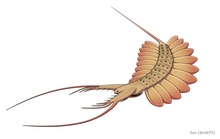Kerygmachelidae is a family of gilled lobopodians (stem-arthropods with flapping trunk appendages and radial mouths) from the Cambrian period. Currently three genera are included in the family: Kerygmachela from the lower Cambrian of Greenland, Utahnax from the middle Cambrian of Utah, and Mobulavermis from the lower-middle Cambrian of Nevada. These animals are characterized by well developed frontal appendages similar to other dinocaridids like the radiodonts, except the ones present in these genera are horizontal to one another, and do not curve downward. These animals were most likely nektonic predators, using their large trunk flaps to swim in the water column, and using their frontal appendages to grab small-sized prey.[1][2][3]
| Kerygmachelidae Temporal range: Lower to Middle Cambrian,
| |
|---|---|

| |
| Restoration of Kerygmachela kierkegaardi | |
| Scientific classification | |
| Domain: | Eukaryota |
| Kingdom: | Animalia |
| Phylum: | Arthropoda |
| Class: | †Dinocaridida |
| Family: | †Kerygmachelidae McCall, 2023 |
| Genera | |
References edit
- ^ Budd, Graham E. (1993), "A Cambrian gilled lobopod from Greenland", Nature, 364 (6439): 709–711, doi:10.1038/364709a0, S2CID 4341971
- ^ Park, Tae-Yoon S.; Kihm, Ji-Hoon; Woo, Jusun; Park, Changkun; Lee, Won Young; Smith, M. Paul; Harper, David A. T.; Young, Fletcher; Nielsen, Arne T.; Vinther, Jakob (2018-03-09). "Brain and eyes of Kerygmachela reveal protocerebral ancestry of the panarthropod head". Nature Communications. 9 (1): 1019. doi:10.1038/s41467-018-03464-w. ISSN 2041-1723. PMC 5844904. PMID 29523785.
- ^ McCall, C. R. A. (2023). "A large pelagic lobopodian from the Cambrian Pioche Shale of Nevada". Journal of Paleontology: 1–16. doi:10.1017/jpa.2023.63.